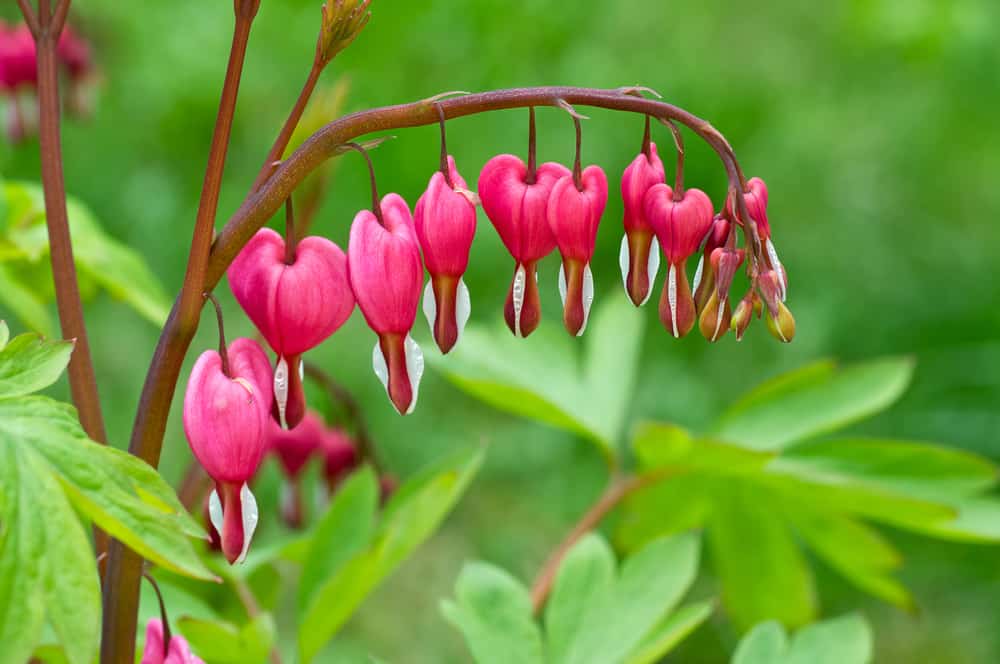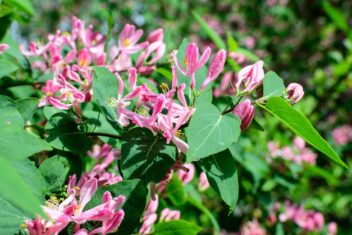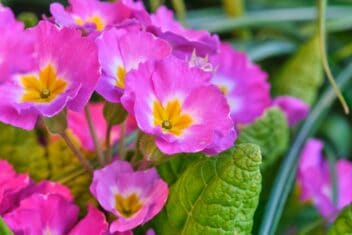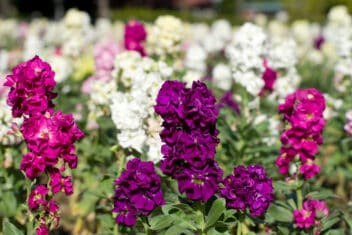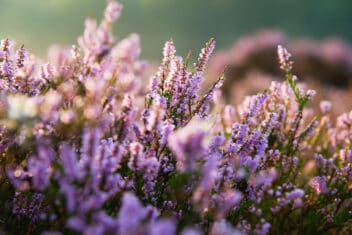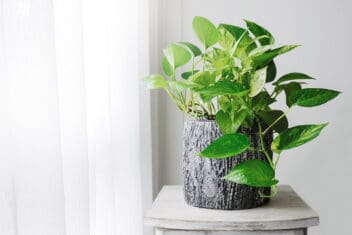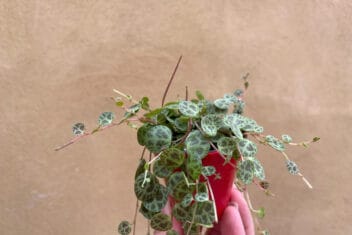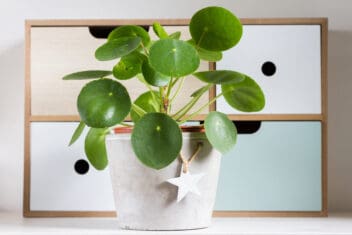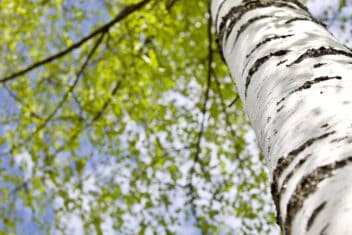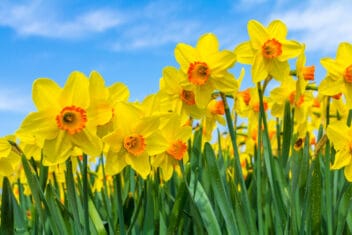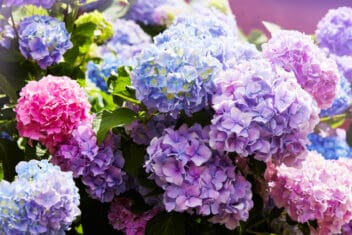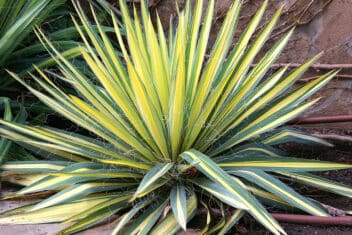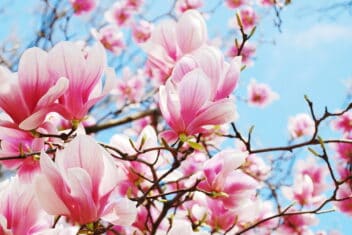Sometimes finding color for a shaded or partially shaded area of the garden can be difficult. Many of the prettiest or most colorful flowering plants are sun lovers. If you have this problem, look no more. We’d like to introduce you to growing bleeding hearts.
Bleeding heart plants have white, pink, or red flowers and thrive in shadier spots. It blooms in the cooler parts of late spring and early summer, giving your garden a beautiful display of pillow-like, heart-shaped flowers where other plants struggle.
Ready to dig into all things bleeding heart?
What is Bleeding Heart Plant?
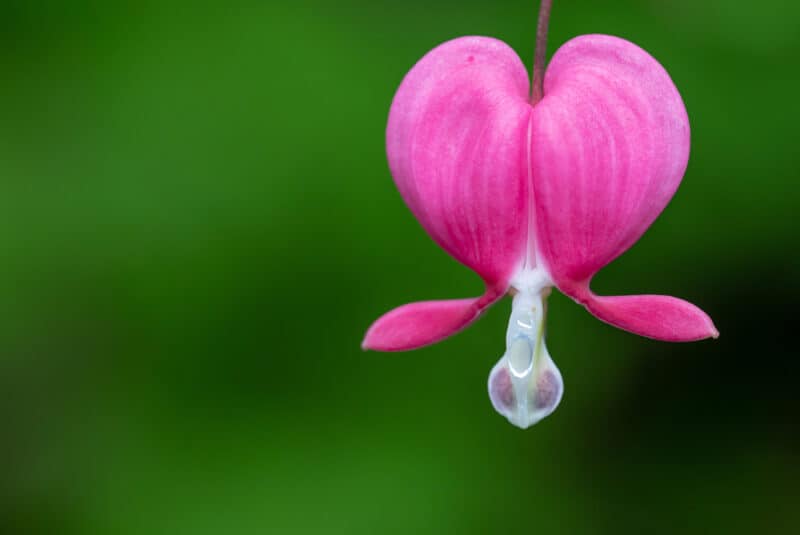
Bleeding heart plant (Lamprocapnos spectabilis) is a herbaceous perennial that grows in early to mid-spring and is a member of the poppy family. Originally from Asia, bleeding hearts came to western countries in the middle of the nineteenth century.
The heart-shaped flowers hang off delicate arched stems and bloom in late spring to early summer. Used to brighten up shaded parts of the garden, bleeding hearts suit cottage or wildflower gardens.
The flowers are relatively short-lived, so consider using them in containers where you can move them out of the garden when they die back in the summer heat. You can also cut them back to the ground and they’ll return next year.
Varieties of Bleeding Heart
This is such a unique-looking plant when in bloom, whichever variety you choose will stand out in the garden.
Alba

This is the favorite bleeding heart of many gardeners. Its pure white flowers look stunning in the dappled sunlight of a shaded area of the garden or woodland.
Valentine
The stems of ‘Valentine’ are burgundy, while the flowers are bright cherry-red with white tips.
Gold Heart
Surprise! The foliage of ‘Gold Heart’ is a lovely golden color. The flowers are a bright, luscious pink.
Zestful
This has slightly different foliage to many other cultivars. It’s more fern-like. The flowers are pink, and unlike other varieties, you may get repeats of blooms throughout the summer.
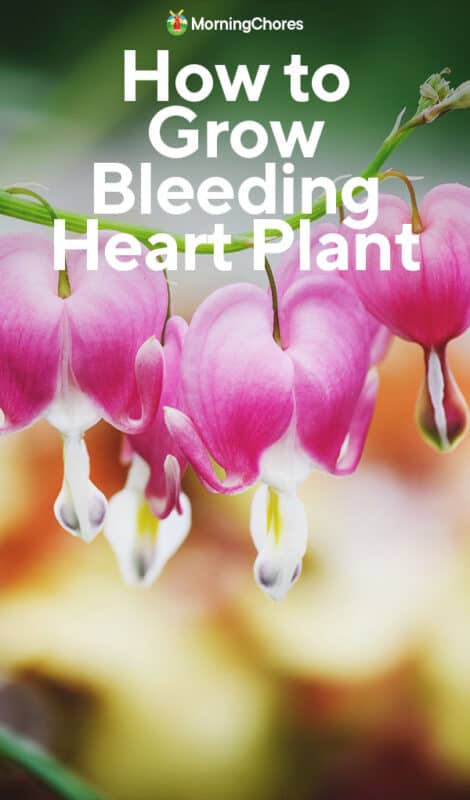
Planting and Propagating Bleeding Hearts
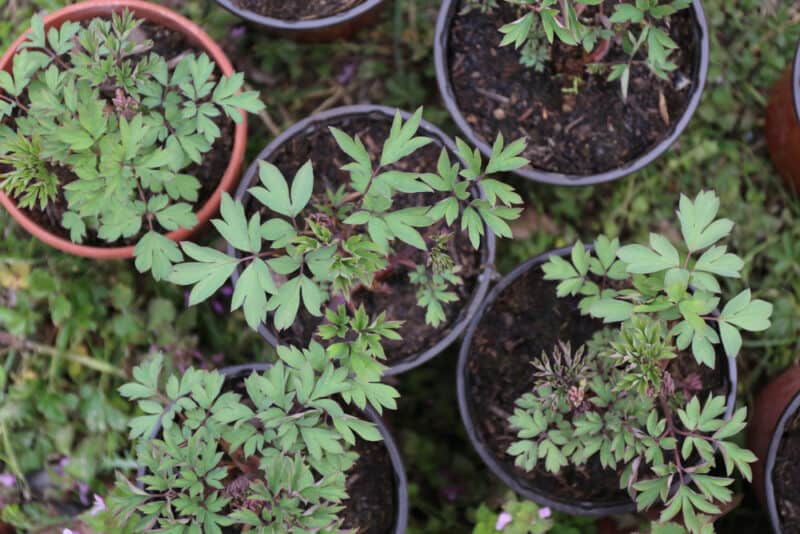
This is a relatively easy plant to propagate, depending on your preference.
Division
Make sure you divide your plant after the bloom has finished so you don’t waste the flowers, given their short life span.
Dig around the plant to loosen the root ball. Be careful, but don’t worry if you cut the roots a little bit.
Now tilt out the rootball a little. You will see little pink buds on the roots. Use clippers or scissors to cut through part of the rootball, making sure there are a few of the pink buds on each section you’re taking.
I prefer to replant into a container, but by all means, dig a fresh hole in the ground, dig in rich organic matter and replant. Water well, but don’t leave the soil soaking.
Cuttings
You can propagate with cuttings. The whole process should take three to four weeks.
Cut a stem about six inches long. Remove the leaves on the bottom 3/4. Some plants don’t need rooting hormones, but I find bleeding heart plants benefit from using it. If you don’t have any, just go ahead and do without.
Make a hole in seed raising mix in a small container. Use your finger, a chopstick, or a pencil. Make the hole about three inches deep.
Stick the stem in the hole and firm the soil around it gently. Water with a spray bottle to make sure the soil is well moistened. Place the container on a warm windowsill out of direct sunlight. You may need to place a plastic bag over the container for extra humidity.
Don’t allow the soil to dry out, but don’t saturate it either. In about three weeks, give the plant a gentle pull. Resistance means roots have formed.
You will need to harden off the bleeding heart plant before you transplant it outside.
Seeds
Sow seeds inside in containers rather than by direct sowing outside. Your success rate will be much higher.
Sow seeds as normal in a small container filled with a seed raising mix. Spray the soil with a misting bottle. Place the container in a plastic bag sealed with a tie or rubber band and put it in the freezer for about six weeks.
After this time, remove the container from the freezer and bag. Place it on a window sill as far from direct light as possible. Each day move it slightly closer to the light and heat of the sun without putting it in direct sunlight. Germination will take place soon after the temperature of the soil in the container warms up.
Self Seeding
Bleeding heart plants often self-seed. When the seedling is about three to five inches tall, gently dig it up and replant it in a container, or directly into the ground elsewhere.
How to Care For Bleeding Hearts
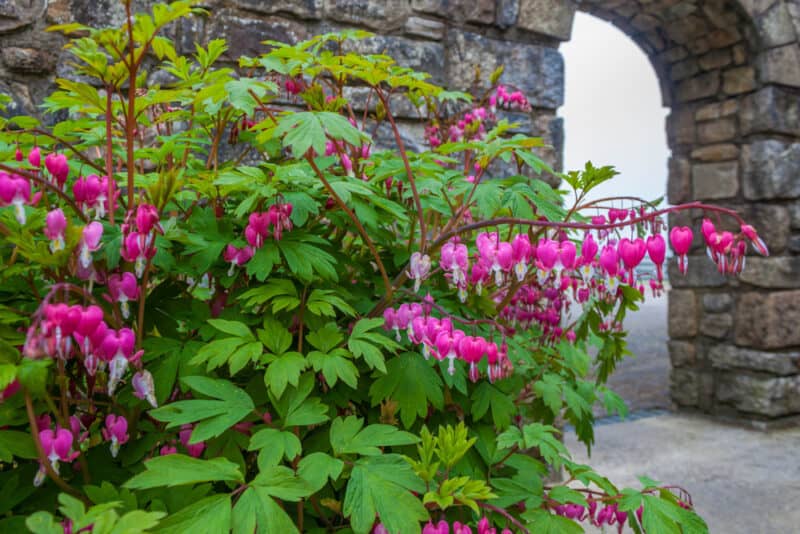
Bleeding heart plants are perfect for growing in USDA Growing Zones 3 to 9. Bloom times vary with different varieties, but remember that bleeding heart plants will usually bloom spectacularly while the weather is cooler at the beginning of summer.
When the weather warms up, the flowers drop off after a number of weeks, then the foliage often dies off. This will leave a gap the size of the plant in your garden, and you’ll need to fill it in with different plants.
You can also plant strategically so that something new will be expanding and blooming just as the bleeding hearts are fading.
The yellowing of leaves after the blooms disappear is normal and is just the plant storing its energy for the next season.
Bleeding heart plants will tolerate varied temperatures from 55ºF to 75ºF. Humidity doesn’t seem to bother it too much.
Plant in a shaded area with minimal direct sunlight. Dappled sun is okay, but if too much sun gets on the plant, it will drop its flowers and the foliage will die back until next year.
Although not too fussy with the pH of the soil, bleeding heart plants love soil full of rich organic matter. If you want to ensure the perfect pH, try 6 to 6.5, but it will tolerate up to 7.5.
Well-draining soil is a must.
Bleeding heart plants need around an inch of water each week during the growing season, so if you haven’t received rainfall, make up by irrigating. If you press your fingertip into the soil and it feels dry up to your first knuckle, add water.
When the plant dies back in the heat of summer, maintain watering the ground to ensure the roots stay hydrated.
You don’t need to prune or deadhead bleeding heart plant. Allow it to go to seed for self-seeding next season, though you will get another plant anyway because the roots have jusst gone dormant underground waiting for next year.
Problems and Solutions for Growing Bleeding Heart Plant
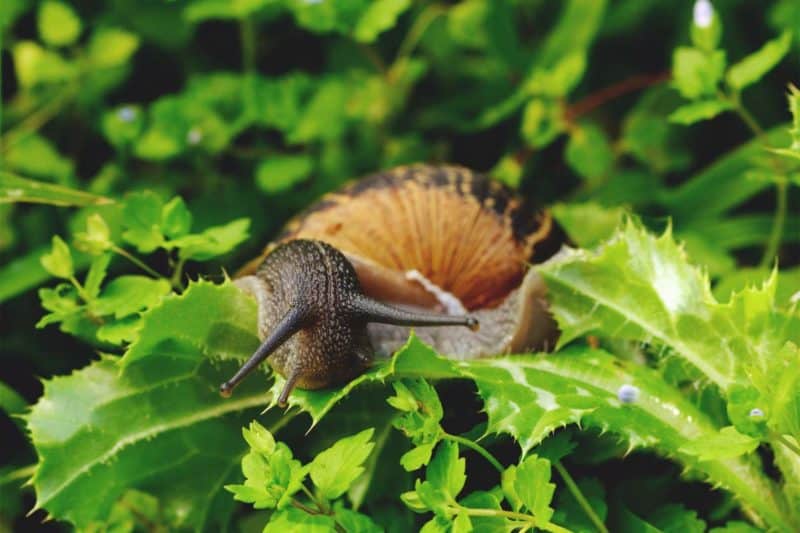
Bleeding hearts raqe pretty hardy, in general, but there are a few problems you might encounter. These are listed below.
There are a few other common diseases that may appear on your bleeding heart plant, but given its short season compared to most other plants in your garden, they don’t often suffer from much else.
Black or Brown Spots on the Leaves
There are several different spots you might see on your plants.
Often you’ll see black or brown spots that don’t change, or they may form a yellow ring on the outside of the spot, or the center of the spot starts to rot. The latter two indicate a fungal condition, likely to be a form of leaf spot.
Use a copper fungicide or homemade baking soda mix. Alternatively, spray regularly in the season with neem oil to try and prevent this from developing.
Yellowing Leaves
Remember the leaves will go yellow once the blooms begin to disappear. If they go yellow too soon, there is another problem to deal with. It could be any of the following:
- Too much water: Being sensitive to excessive watering, bleeding heart plants will let you know with yellowing of the leaves. Check the soil. If its wet, pull back on the water and see if the plant improves.
- The soil is too alkaline: Check the pH of the soil. Although bleeding heart plants are not too fussy with soil, this could be an issue. Amend the soil by adding peat moss, compost, wood chips, sulfur or well-rotted and balanced compost.
- Too much sun: This could be an issue if you placed the bleeding heart plant in a sunny position, or something happened that now exposes the area to direct sun. Remember if you prune, trim or remove other plants, you may change the conditions for others. If this is the case, provide shade for the bleeding heart plant with shade cloth or additional planting of other species.
- Aphids: Aphids suck the sap out of plants, weakening their overall health. Read our article on how to spot and treat plants for aphids here.
No Blooms
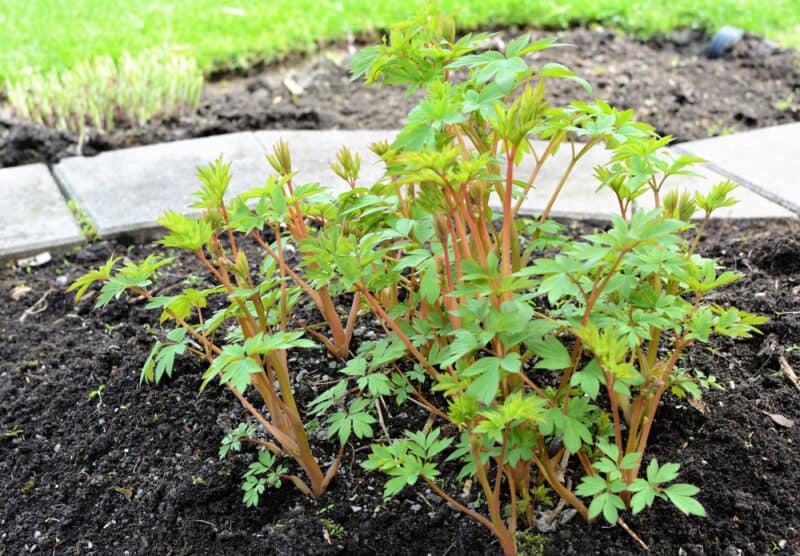
If this is the first year for your bleeding heart plant, you may not get any flowers. This is common for the first year. If it’s an older plant growing from last season, cut it right back to an inch above the soil.
Feed with a slow-release 5-10-5 fertilizer and water well without saturating the soil. Fertilize every six weeks until the plant blooms or summer is over. Your bleeding heart will likely start growing and blooming again next year.
Slugs and Snails
Any plant in a shaded area of the garden is a target for slugs and snails. Without direct sunlight, these pests can come out earlier and hide away later. I prefer to use slug pellets with a bittering agent to stop animals and birds from eating them. Or, you could come out at night and remove them by hand.
Scale
Although not overly common, I’ve had a couple of seasons where scale has been an issue on my bleeding heart plant. It will suffer if the infestation is large. Read our article on how to identify and treat for scale here.
